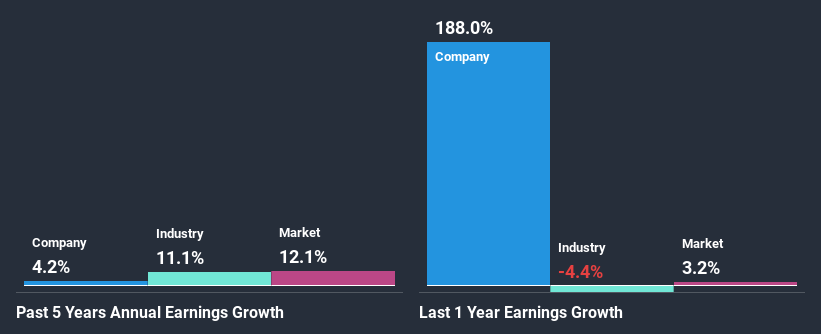Kimco Realty Corporation's (NYSE:KIM) Stock On An Uptrend: Could Fundamentals Be Driving The Momentum?
Kimco Realty (NYSE:KIM) has had a great run on the share market with its stock up by a significant 26% over the last three months. We wonder if and what role the company's financials play in that price change as a company's long-term fundamentals usually dictate market outcomes. Specifically, we decided to study Kimco Realty's ROE in this article.
Return on equity or ROE is a key measure used to assess how efficiently a company's management is utilizing the company's capital. In simpler terms, it measures the profitability of a company in relation to shareholder's equity.
See our latest analysis for Kimco Realty
How Do You Calculate Return On Equity?
ROE can be calculated by using the formula:
Return on Equity = Net Profit (from continuing operations) ÷ Shareholders' Equity
So, based on the above formula, the ROE for Kimco Realty is:
18% = US$1.0b ÷ US$5.7b (Based on the trailing twelve months to December 2020).
The 'return' is the profit over the last twelve months. So, this means that for every $1 of its shareholder's investments, the company generates a profit of $0.18.
What Is The Relationship Between ROE And Earnings Growth?
So far, we've learned that ROE is a measure of a company's profitability. Depending on how much of these profits the company reinvests or "retains", and how effectively it does so, we are then able to assess a company’s earnings growth potential. Assuming all else is equal, companies that have both a higher return on equity and higher profit retention are usually the ones that have a higher growth rate when compared to companies that don't have the same features.
Kimco Realty's Earnings Growth And 18% ROE
To begin with, Kimco Realty seems to have a respectable ROE. Especially when compared to the industry average of 5.0% the company's ROE looks pretty impressive. However, for some reason, the higher returns aren't reflected in Kimco Realty's meagre five year net income growth average of 4.2%. This is generally not the case as when a company has a high rate of return it should usually also have a high earnings growth rate. Such a scenario is likely to take place when a company pays out a huge portion of its earnings as dividends, or is faced with competitive pressures.
Next, on comparing with the industry net income growth, we found that Kimco Realty's reported growth was lower than the industry growth of 11% in the same period, which is not something we like to see.
The basis for attaching value to a company is, to a great extent, tied to its earnings growth. It’s important for an investor to know whether the market has priced in the company's expected earnings growth (or decline). By doing so, they will have an idea if the stock is headed into clear blue waters or if swampy waters await. What is KIM worth today? The intrinsic value infographic in our free research report helps visualize whether KIM is currently mispriced by the market.
Is Kimco Realty Making Efficient Use Of Its Profits?
Kimco Realty has a very high three-year median payout ratio of86%, implying that it retains only 14% of its profits. However, it's not unusual to see a REIT with such a high payout ratio mainly due to statutory requirements. Accordingly, this suggests that the company's earnings growth was lower as a result of the high payout.
Moreover, Kimco Realty has been paying dividends for at least ten years or more suggesting that management must have perceived that the shareholders prefer dividends over earnings growth. Upon studying the latest analysts' consensus data, we found that the company's future payout ratio is expected to drop to 55% over the next three years. However, Kimco Realty's future ROE is expected to decline to 5.6% despite the expected decline in its payout ratio. We infer that there could be other factors that could be steering the foreseen decline in the company's ROE.
Conclusion
On the whole, we do feel that Kimco Realty has some positive attributes. Yet, the low earnings growth is a bit concerning, especially given that the company has a high rate of return. Investors could have benefitted from the high ROE, had the company been reinvesting more of its earnings. As discussed earlier, the company is retaining a small portion of its profits. Having said that, on studying current analyst estimates, we were concerned to see that while the company has grown its earnings in the past, analysts expect its earnings to shrink in the future. To know more about the company's future earnings growth forecasts take a look at this free report on analyst forecasts for the company to find out more.
This article by Simply Wall St is general in nature. It does not constitute a recommendation to buy or sell any stock, and does not take account of your objectives, or your financial situation. We aim to bring you long-term focused analysis driven by fundamental data. Note that our analysis may not factor in the latest price-sensitive company announcements or qualitative material. Simply Wall St has no position in any stocks mentioned.
Have feedback on this article? Concerned about the content? Get in touch with us directly. Alternatively, email editorial-team (at) simplywallst.com.

